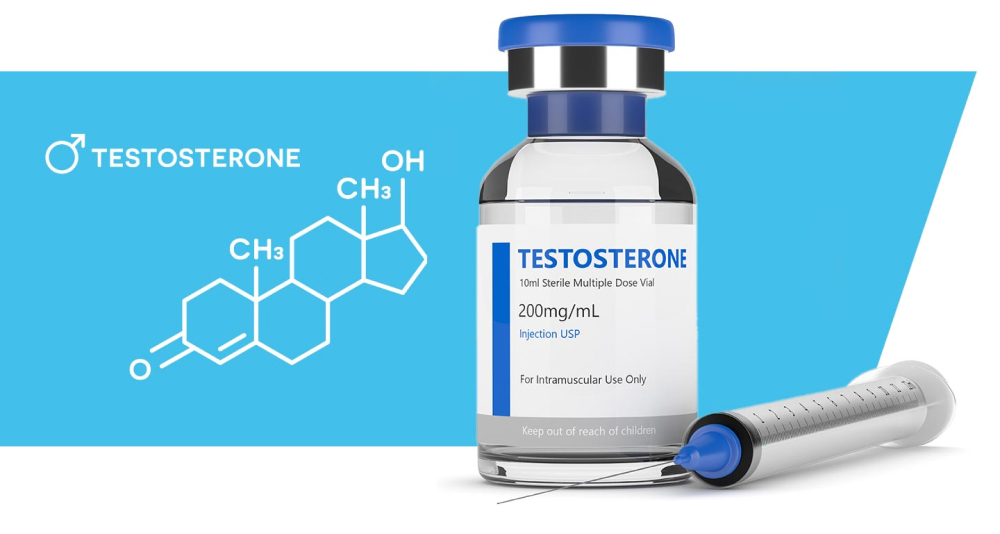Testosterone therapy can help improve mood, energy, and sexual function.
HRT (hormone-replacement therapy) is a common treatment for individuals with low testosterone levels.
But how is it administered? Two popular methods of this hormone replacement therapy are pellets and injections.
Each has its own benefits and drawbacks. This article delves into the specifics of testosterone pellets vs. injections.
You’ll learn how each method works, their costs, and potential side effects. Our goal is to provide you with the information you need to make an informed decision about your testosterone therapy. Let’s dive in.
Understanding Testosterone Therapy
Testosterone therapy plays a critical role in treating low testosterone, also known as hypogonadism. Over time, low testosterone may cause a man to lose body hair, muscle bulk, cause weak bones (osteoporosis), low red blood cells, and smaller testes. Signs and symptoms vary from person to person, but can include fatigue, depression, and decreased libido.
Personalized treatments at NW Regen help you rediscover your inner equilibrium and vigor with our Bioidentical Hormone Therapy (BHRT), a safe, well-researched and proven treatment using hormones derived from plant sources that are chemically similar to the hormones your body naturally produces.

This therapy is not just for men. Women can also benefit from testosterone therapy to manage hormonal imbalances. Understanding how testosterone impacts your body is essential. This hormone influences many bodily functions, including muscle mass and bone density.
Hormone Replacement Therapy
HRT stands for hormone replacement therapy. It’s a medical treatment that replaces hormones that the body is no longer producing or isn’t producing enough of.
Dr. Ryan Wood of NW Regen explains the therapies offered at his clinic. “There are two forms of HRT we do regularly in our clinic and there are pluses and minuses to both,” says Dr. Wood. “Briefly, HRT via pellets allows for a steady, long-lasting release of hormones that is closer to the natural release our bodies have, while HRT injections offer a rapid-acting and shorter boost.”
Through testosterone therapy, individuals may achieve improved quality of life. However, not everyone is a candidate for this treatment. Consulting with a healthcare provider is crucial before starting any form of testosterone therapy to ensure safety and effectiveness. Book your consultation with Dr. Ryan Wood at NW Regen, today.
Testosterone Pellets: An Overview
Testosterone pellets are small, cylindrical implants placed under the skin to release the hormone steadily. Typically, they are inserted into the hip area through a simple procedure.
These pellets provide a long-term solution, often lasting three to six months, reducing the need for frequent medication. This pellet HRT method eliminates the daily or weekly dosing seen with other forms of therapy.
According to Dr. Ryan Wood of NW Regen, “Pellets are slightly more expensive with little to no maintenance after being painlessly implanted under the skin using a 10-minute minor surgical procedure. Testosterone injections are twice weekly self-administered and are less expensive.”
“Cost is an issue with pellets but offers little-to-no-maintenance once implanted,” explains Dr. Wood. “Plus, HRT pellets provide a better steady-state level of hormones with less overall fluctuations. I will always recommend these over injections when possible.”
How Pellets Work and Their Administration
The administration is relatively quick and minimally invasive. A healthcare provider makes a small incision and inserts the pellet, usually in just a few minutes. Once implanted, testosterone pellets slowly dissolve, releasing the hormone directly into the bloodstream. This consistent delivery ensures stable hormone levels over time.
Pros and Cons of Testosterone Pellets
Testosterone pellets offer several notable benefits. They provide a steady hormone release, reducing the fluctuations seen with other methods. This consistent delivery can lead to more stable mood and energy levels.
However, there are some downsides to consider. The procedure requires a visit to the healthcare provider for insertion. Once implanted, adjusting the dose isn’t possible until the next round.
Pros:
- Stable hormone levels
- Long-lasting effect
- Fewer medical visits
Cons:
- Invasive procedure for insertion
- Inflexible dosing
- Possible irritation at the implantation site
Understanding these benefits and drawbacks will help you make informed choices about your treatment. To talk with a physician about the pros and cons and your personal needs, book a consultation with Dr. Ryan Wood, today. Or explore more information about our Men’s Health services on our website.
Testosterone Injections: An Overview
Testosterone injections are a common method of hormone replacement therapy. This approach involves administering testosterone directly into the muscle, providing effective results.

How Injections Work and Their Administration
Administering injections requires either a clinic visit or self-administration at home. Patients should be trained by healthcare professionals to ensure safe and effective injection techniques. Once injected into the muscle, testosterone is absorbed into the bloodstream gradually. This helps ensure that the body receives the hormone over a set period.
Pros and Cons of Testosterone Injections
Testosterone injections have several advantages:
- They offer flexibility in dosage, allowing for adjustments based on individual needs.
- Moreover, self-administration can be convenient for those comfortable with the process.
Dr. Ryan Wood explains, “Injections are by far the most common form of administration. The convenience and cost of injections can be very attractive to some people who don’t mind self-injections and the fluctuations with intramuscular injections.”
He goes on to explain, “Injections require more maintenance, and the injection of testosterone is often in doses that are higher than needed to maintain a steady state in the bloodstream. Pellets offer more steady-state blood levels with less fluctuations and side effects. While injections are rapid-acting, and the dosing can be adjusted for easier fine-tuning.”
Yet, some challenges accompany this method. The ‘peak-and-trough’ effect can cause fluctuating hormone levels, leading to mood swings in some individuals. Patients with needle aversions may prefer alternative therapies.
Pros:
- Adjustable dosing
- Suitable for self-administration
- Reliable and effective
Cons:
- Regular administration required
- Potential hormone level fluctuations
- Inconvenience for those uneasy with needles
Understanding these aspects aids individuals in evaluating whether this form of testosterone therapy aligns with your lifestyle and treatment goals.
Comparing Efficacy: Absorption and Hormone Release
In testosterone therapy, absorption and hormone release vary between pellets and injections. Each method’s absorption and release characteristics significantly influence treatment outcomes and should be considered in decision-making.
- Testosterone pellets provide a steady release, allowing for consistent hormone levels over time. This can reduce hormonal fluctuations, offering more stable symptom management.
- In contrast, injections often lead to peak-and-trough effects, causing hormone levels to rise and fall between doses. Some patients may notice a variation in symptom relief during the dosage cycle.
Frequency and Convenience: Pellets vs. Injections
Testosterone pellets offer the convenience of infrequent administration, typically requiring placement every three to six months. This makes them ideal for individuals with demanding schedules or those who prefer fewer medical appointments.
In comparison, testosterone injections typically require more frequent administration, often weekly or biweekly. This can be seen as less convenient, as it may necessitate regular clinic visits or self-administration at home. This need for frequent doses may disrupt some patients’ routines, influencing their choice between pellets and injections, based on their specific lifestyle preferences.

Side Effects and Safety Considerations
Testosterone therapy may result in side effects, which can vary between pellets and injections.
Common side effects of both types of HRT can include mood changes, acne, and changes in libido.
- Testosterone pellets may present a risk of site irritation or infection due to the implantation process.
- Testorsterone injections can lead to highs and lows in hormone levels, potentially causing mood swings or energy fluctuations.
Monitoring by healthcare providers is essential to manage these side effects and ensure optimal therapy outcomes. Safety considerations should be discussed thoroughly with a healthcare professional before starting treatment.
At NW Regen, all of our treatments are highly personalized. And your treatment begins with a consultation with Dr. Ryan Wood to assess your needs. You can book your consultation today!
Cost Analysis: Testosterone Pellets vs Injections
The cost of testosterone therapy can differ significantly between pellets and injections.
- PELLETS: Typically, testosterone pellets have a higher upfront cost due to the procedure required for implantation. However, the benefits of fewer doses could offset the cost for some patients.
- INJECTIONS: On the other hand, injections generally have lower initial costs but require frequent dosing and potentially higher long-term expenses for supplies.
Insurance coverage can also vary, affecting out-of-pocket costs. It’s crucial to evaluate both the short-term and long-term costs with your healthcare provider.

Making the Choice: Factors to Consider
Choosing between testosterone pellets and injections depends on several factors. These include your lifestyle, budget, and comfort with medical procedures.
- PELLETS: For some, the convenience of fewer doctor visits makes pellets appealing.
- INJECTIONS: Others may prefer the flexibility of adjusting doses with injections.
Additionally, medical conditions, needle sensitivity, or personal preferences can influence your decision. Discuss these factors with your healthcare professional. It’s important to consider both the physical and psychological impacts of each method. A tailored approach can optimize therapy results for your unique needs.
Personalized Testosterone Therapy
When it comes to testosterone therapy, personalization is key. Personalized treatments at NW Regen can help you rediscover your inner equilibrium and vigor.
Both pellets and injections have unique benefits and challenges. At NW Regen, you will work closely with Dr. Ryan Wood to select the best method for your lifestyle and health goals. A thoughtful approach ensures effective and safe testosterone therapy tailored to your needs.
NW Regen’s Very Personalized Approach
Your particular blend of hormones, unique to your body, is key to unlocking a rejuvenated self. As your hormone levels naturally decrease with age, they affect not just fertility but also brain, bone, muscle, joint, and cardiovascular health. This decline can accelerate the aging process and contribute to chronic disease. Both men and women need to work with someone who can help find the best therapy options for their unique body.
Bioidentical Hormone Therapy (BHRT) is available in a variety of forms. At NW Regen, we will answer your questions and help you navigate the often complicated world of hormones and hormone therapy. And we work with you to determine the best, most personalized treatment for you.
Contact us today to set up your consultation with Dr. Ryan Wood.
NW Regen
We offer regenerative and interventional medicine – tailored to empower you with a more vibrant, active lifestyle.


